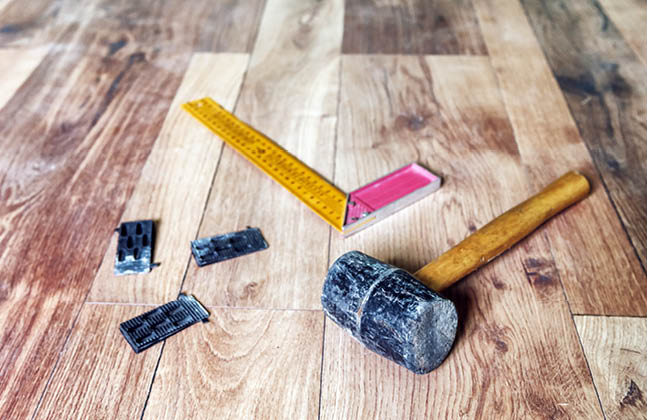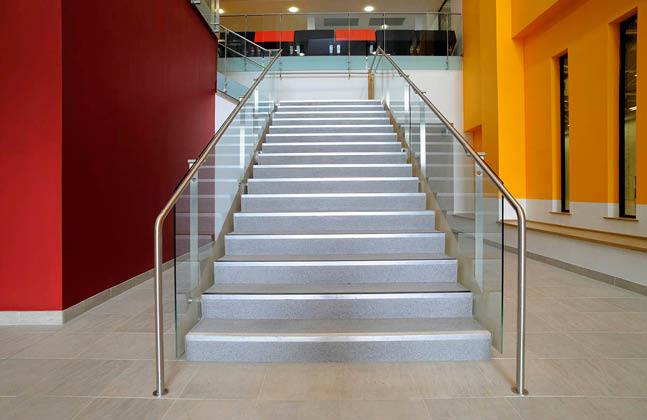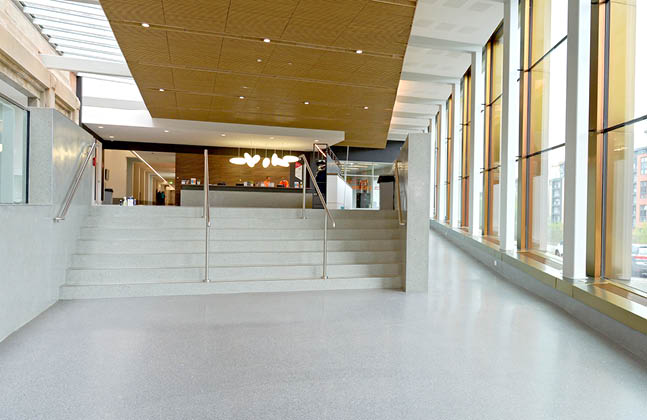While it is crucial to choose the best flooring solution based on your facility’s needs — it is just as important to select the correct method of installation. For certain types of flooring materials, there are three common methods of installation: floating, nail-down, and glue-down. Here, we will examine the pros and cons of floating floors vs non-floating floors and the options to consider to help make your decision making just a little less stressful.
Pros and Cons of a Floating Floor vs a Non-Floating Floor
When it comes to distinguishing between installing a floating floor vs a nail-down or glue-down type method, it is imperative that you weigh the good along with the bad before making any final decisions.
One of the most obvious advantages that a floating floor has over a non-floating floor is ease of installation. Floating floors can be pieced together like a puzzle — leading to a more cost-effective and environmentally friendly approach by eliminating smelly and messy adhesives and shortening the time spent on installation.
Another key advantage of choosing a floating floor over a non-floating type is how it reacts to changes in humidity. Floating floors are installed in one big piece, and if not for wall confinement, the surface could theoretically be moved. This is a positive aspect because it allows the flooring to adapt by expanding and contracting to alterations in the room’s humidity.
On the downside, however, floating floors are prone to faster wear than its counterpart. Floating floors generally incorporate thinner materials that cannot be sanded — often leading to a shorter lifespan. Therefore, commercial spaces that experience heavier than normal foot traffic such as retail stores, office spaces, and restaurants may find a nail-down or glue-down installation more beneficial in the long run.
Another floating floor disadvantage is that this method can be more noisy and hollow-sounding than a traditional nail-down or glue-down type methods. This mainly occurs due to poor-quality flooring materials or faulty installation with no underlayment being added. Thick (¼”) cork underlayment can help deaden any unwanted noises, however, and can be installed directly underneath any manufacturer required vapor barrier.

Wooden flooring is a popular floating floor trend
Popular Floating Floor Trends
Laminate:
Due to its synthetic blend, laminate is more affordable than more premium natural options, such as wood, ceramic tile or stone. However, commercial grade laminate flooring still provides great durability, as it resists scratches, sunlight, and even heavy wear and tear. Since laminate uses digital images, it can take on the look of nearly any natural material with limitless colors and finishes, such as smooth, distressed, textured and more. As a prime example of a floating floor, nearly all laminate products are installed through the floating method which allows the boards to respond better to changes in humidity.
WPC Flooring:
Although the ‘W’ in WPC stands for wood, this type of flooring doesn’t actually contain wood in the traditional sense. It is, however, a composite material that is made up of a combination of wood flour or fibers and heated thermoplastic resins. Together, these materials surpass other conventional types of flooring pertaining to care, durability, and water resistance.
Engineered Hardwood:
Unlike solid wood, engineered wood will not expand or contract as easily due to changing temperatures or humidity. Therefore, if you are looking to upgrade an area of your facility with hardwood floors but have concerns regarding buckling and warping due to moisture, a floating engineered approach may be just what you are looking for.
Cork Flooring:
From preserving the quality of wine in bottles to being used as an office board that holds important information, cork can be used in a wide range of applications. Yet one of the most unique applications comes in the form of cork flooring and just may give you the feeling as if you are walking on a cloud.
Popular Non-Floating Floor Options
Luxury Vinyl Tile:
Short for luxury vinyl tile, LVT is designed to replicate hard surface flooring materials such as stone or wood, yet provide many more practical benefits. Using a realistic photographic print film and a clear vinyl layer, LVT is available in a wide variety of design concepts. Products such as Versalock Floating Floors from Shaw allows the planks to lock together without being adhered to the subfloor.

Luxury Vinyl Tile is designed to replicate materials such as stone or wood
Resin Flooring:
Resin flooring is a combination of materials that, when mixed together, form a chemically hardened plastic-like surface. While there are many different types of resin floors to choose from, the most common types are epoxy, polyurethane resin, and acrylic resin. Each of these types are part of a two-way system consisting of a base material and a hardening material. Once combined, a chemical reaction between the two causes the materials to harden creating a chemical resistant epoxy flooring.

Resin flooring is a combination of a base material and hardening material, used to make robust coatings
Ceramic and Stone Tile:
Typically mortared to a substrate, porcelain and stone tile are exceedingly durable and offer excellent lasting quality. Both ceramic and stone provide a premium, high-end finish and can come in a broad range of colors and textures. Natural stone tiles in particular offer one-of-a-kind finishes, as each stone is unique, differing in color, feel and composition.





